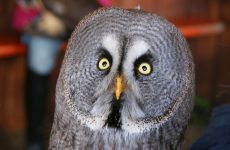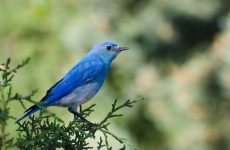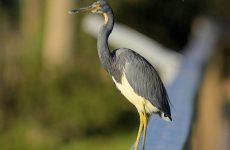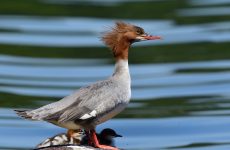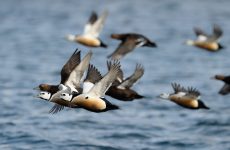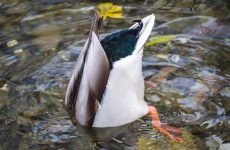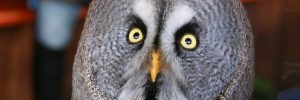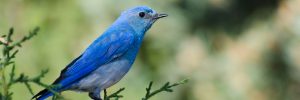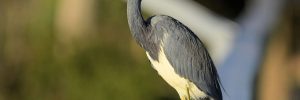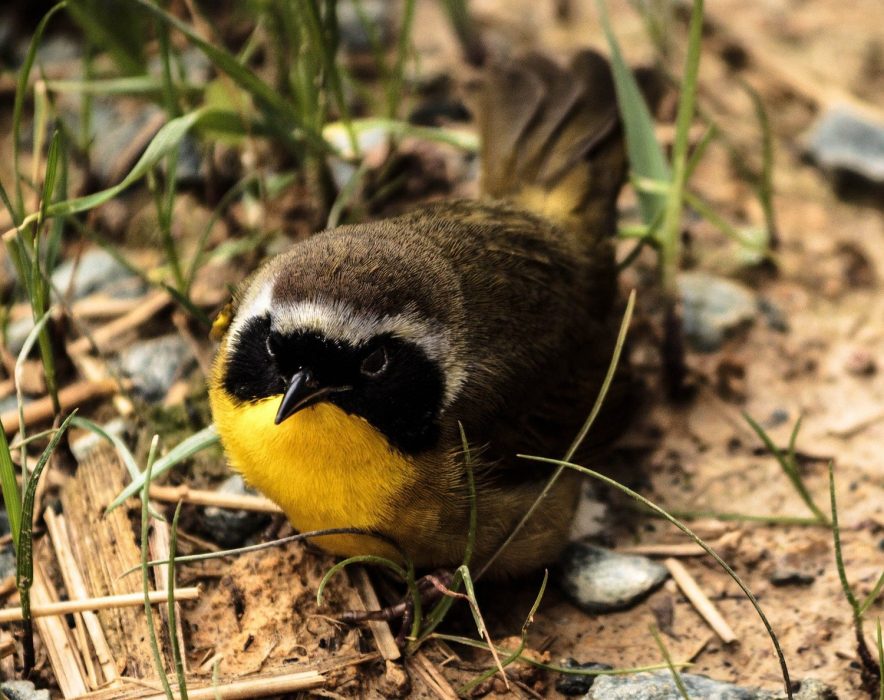
Do you know a warbler from sparrow or wish to tick off the 40 most common small birds across the US and Canada?
You may be in your backyard or out on a walk but knowing what small birds are brightening up your day has just got easier with this small birds guide.
These small birds are all 9 inches or less in length and are commonly spotted in the US and Canada, so don’t delay get spotting.
Also, get a free picture ID printable for backyard birds for every state to really get you spotting.
40 Common Small Birds
- Dark-eyed Junco
- Northern Cardinal
- Downy Woodpecker
- House Finch
- Gray Catbird
- Common Yellowthroat
- European Starling
- American Goldfinch
- Song Sparrow
- Black-capped Chickadee
- White-breasted Nuthatch
- Chipping Sparrow
- Tufted Titmouse
- Yellow-rumped Warbler
- House Sparrow
- Northern Flicker
- Carolina Wren
- White-throated Sparrow
- Ruby-crowned Kinglet
- Carolina Chickadee
- Tree Swallow
- Yellow Warbler
- House Wren
- Red-eyed Vireo
- Cedar Waxwing
- Indigo Bunting
- Great Crested Flycatcher
- Baltimore Oriole
- Eastern Bluebird
- Eastern Towhee
- Annas Hummingbird
- Northern Parula
- Blue-Gray Gnatcatcher
- Eastern Phoebe
- Hairy Woodpecker
- Yellow Warbler
- Ruby-throated Hummingbird
- Golden-crowned Sparrow
- Chestnut-backed Chickadee
- Bushtit
40 Small Birds That You Should Know
1. Dark-eyed Junco
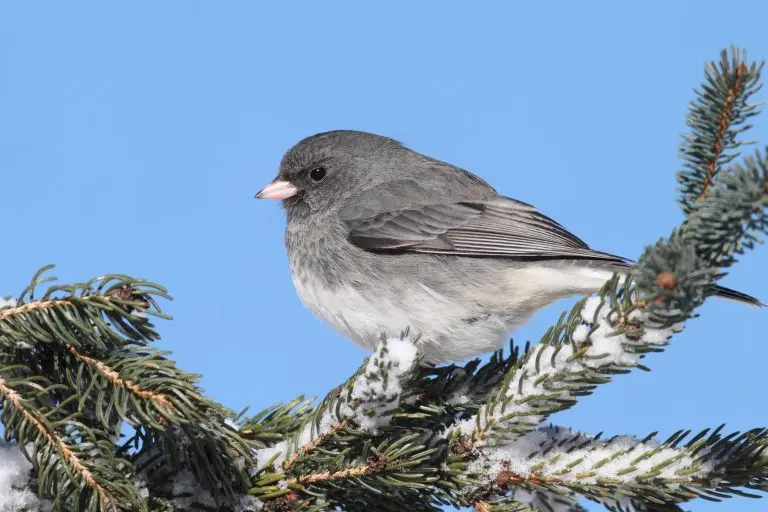
Dark-eyed Juncos are sparrows that are different colors depending on the state. They are generally slate-colored in the east and black, white, and brown in the west.
- Length: 5.5-6.3 in (14-16 cm)
- Weight: 0.6-1.1 oz (18-30 g)
- Wingspan: 7.1-9.8 in (18-25 cm)
Some remain resident all year in the northeast, west and Appalachian Mountains. Those that breed in Canada and Alaska migrate south in winter to much of the United States.
They can be found in open and partially wooded areas often on the ground and are common across the continent.
You can attract more Dark-eyed Juncos to backyard feeders with a variety of seeds such as black oil sunflower seeds, nyjer, cracked corn, millet, and peanuts. Platform feeders or scattered on the ground are best.
2. Northern Cardinal
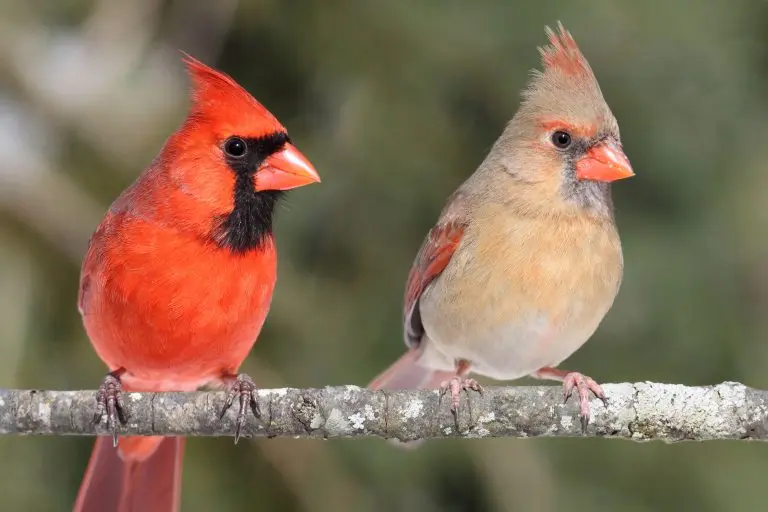
The bright red male Northern Cardinal with black around their faces is a great sight, especially against a white winter background.
Females are also a little showy with their brown coloring, sharp brown crest, red highlights, and red beaks.
- Length: 8.3-9.1 in (21-23 cm)
- Weight: 1.5-1.7 oz (42-48 g)
- Wingspan: 9.8-12.2 in (25-31 cm)
Northern Cardinals live in the Eastern half of the US all year.
Northern Cardinals will sometimes attack their own reflection during breeding season as they obsessively defend their territories.
You can attract more Northern Cardinals to backyard feeders with sunflower seeds, peanut hearts, millet, and milo.
They will feed from large tube feeders, hoppers, platform feeders, or food scattered on the ground.
3. Downy Woodpecker
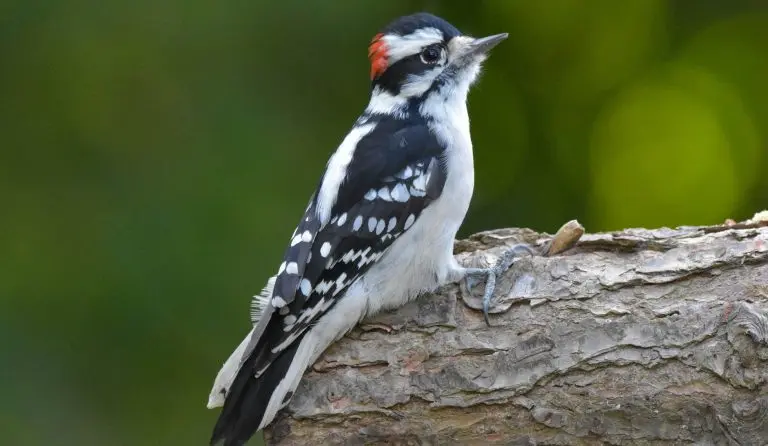
Downy Woodpeckers are common in the US and Canada.
Downy Woodpeckers are small birds that are common at backyard feeders. They are often mixed in with other birds such as chickadees and nuthatches.
They have black and white coloring with a red patch at the back of their heads. They look similar to the Hairy Woodpecker but smaller.
- Length: 5.5-6.7 in (14-17 cm)
- Weight: 0.7-1.0 oz (21-28 g)
- Wingspan: 9.8-11.8 in (25-30 cm)
Downy woodpeckers can be found in woodlots, along streams, city parks, and backyards and eat mainly insects beetle larvae, but also berries, acorns, and grains.
To attract more Downy Woodpeckers to your backyard try suet feeders but they will also eat black oil sunflower seeds, millet, and peanuts on platform feeders.
4. House Finch
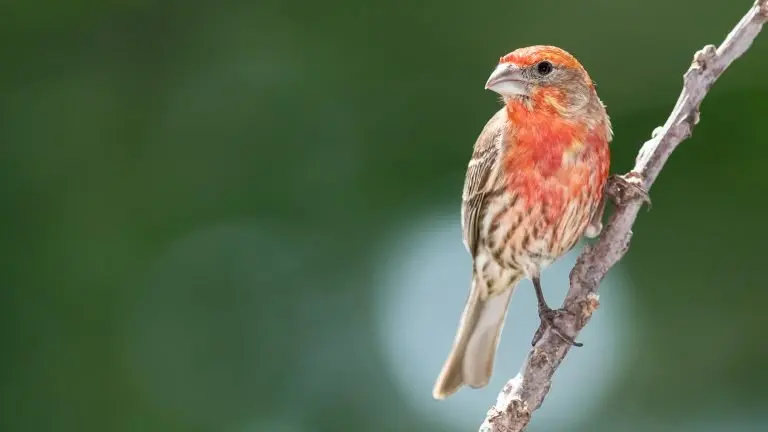
House Finches have a red head and breast in the males and brown-streaked coloring in the females.
- Length: 5.1-5.5 in (13-14 cm)
- Weight: 0.6-0.9 oz (16-27 g)
- Wingspan: 7.9-9.8 in (20-25 cm)
Originally only in Western States, House Finches were introduced to the Eastern States and have done very well, even pushing out the Purple Finch.
They can be found in parks, farms, forest edges, and backyard feeders. They can be found in noisy groups that are hard to miss.
You can attract more House Finches to backyard feeders with black oil sunflower seeds or nyjer seeds in tube feeders or platform feeders.
5. Gray Catbird
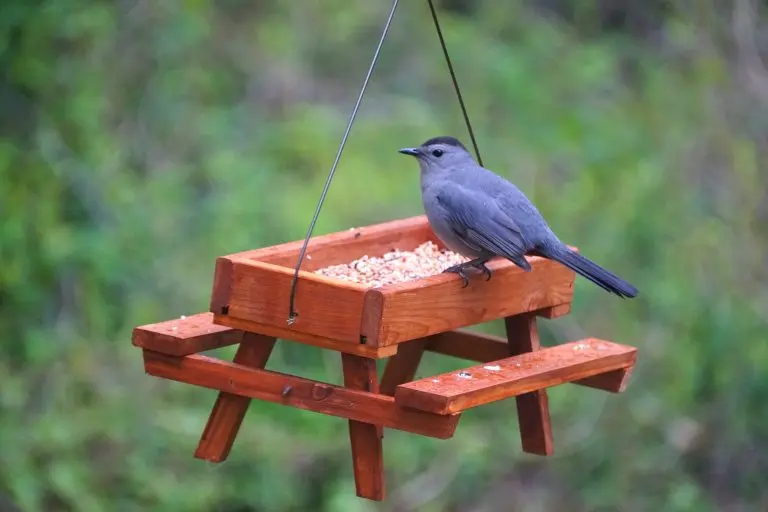
Gray Catbirds are so named because of their distinctive catty mew song that can last for up to 10 minutes. They are medium-sized songbirds with a slate gray coloring, black cap and tail, and a reddish patch under their tails.
- Length: 8.3-9.4 in (21-24 cm)
- Weight: 0.8-2.0 oz (23.2-56.5 g)
- Wingspan: 8.7-11.8 in (22-30 cm)
Gray Catbirds breed in the Mid-west, Eastern States and southern Canada before heading to the Gulf Coast and the Caribbean for winter. Some remain all year along the East Coast.
You can spot Gray Catbirds in dense shrubs, small trees, and along forest edges or hedgerows.
You can attract more Gray Catbirds to your backyard feeders with fruit and fruit trees or shrubs such as dogwood, winterberry, and serviceberry.
6. Common Yellowthroat
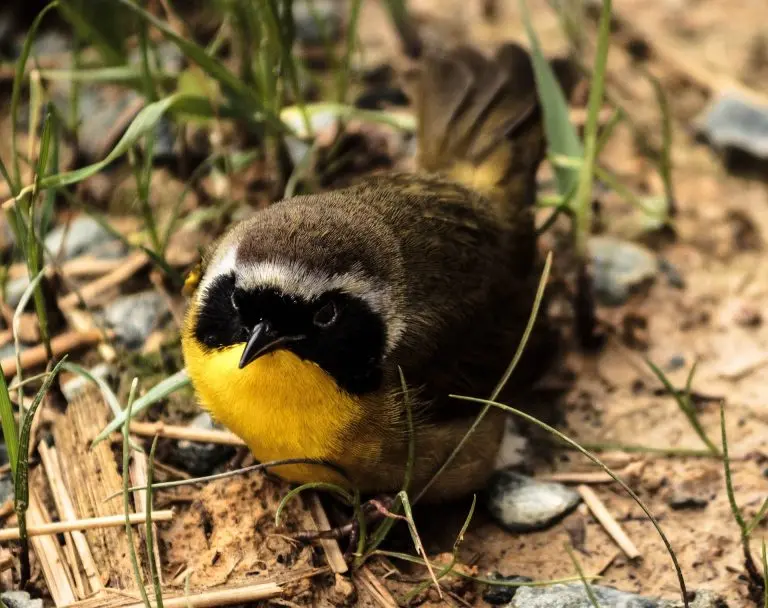
Common Yellowthroats are small songbirds that are brownish on the back and bright yellow underneath, with long tails. The males have a black mask across the face. The brightness of the yellow can vary geographically and they may be more olive in parts underneath.
- Length: 4.3-5.1 in (11-13 cm)
- Weight: 0.3-0.3 oz (9-10 g)
- Wingspan: 5.9-7.5 in (15-19 cm)
Common Yellowthroats spend the summer breeding over most of North America, except Alaska and northern Canada. Some remain all year along the Gulf Coast and Pacific Southwest.
They can be found in the spring and summer often in marshy or wetland areas and brushy fields living in thick, tangled vegetation.
They eat mostly insects and will be found in large backyards that have dense vegetation.
7. European Starling
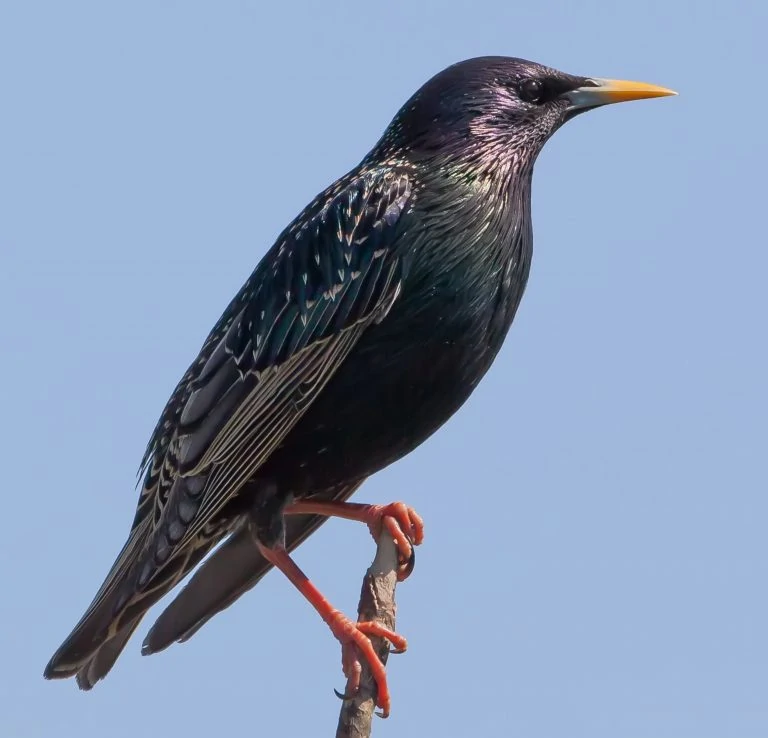
European Starlings are not native but are now one of the most numerous songbirds. They are stocky black birds with iridescent purple, green, and blue tones.
- Length: 7.9-9.1 in (20-23 cm)
- Weight: 2.1-3.4 oz (60-96 g)
- Wingspan: 12.2-15.8 in (31-40 cm)
European Starlings live in all North America, except the north of Canada and Alaska.
Considered a pest by some due to their aggressive behavior these birds fly in large noisy flocks and can be seen perched in groups on the top of trees or flying over fields in flocks.
Starlings eat predominantly insects including beetles, flies and caterpillars, earthworms, and spiders. They also eat fruit including cherries, holly berries, mulberries, Virginia Creeper, sumac, and blackberries, as well as grains and seeds.
You can attract more European Starlings to your backyard feeders with black oil sunflower seeds, suet, cracked corn, and peanuts.
8. American Goldfinch
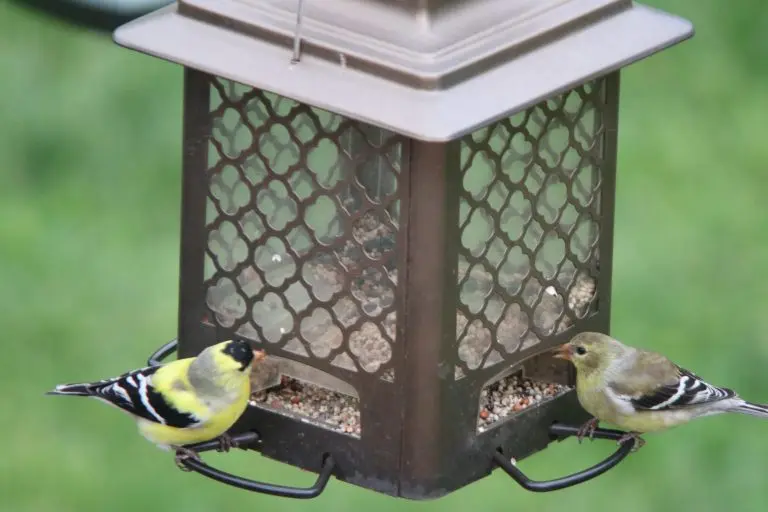
American Goldfinches are popular birds with the males bright yellow and black coloring in spring. The females are more dull brown as are males in winter.
- Length: 4.3-5.1 in (11-13 cm)
- Weight: 0.4-0.7 oz (11-20 g)
- Wingspan: 7.5-8.7 in (19-22 cm)
American Goldfinches can be found in most of North America. They breed in Canada and the Mid-West and Canada before migrating to Southern States, they remain all year in the rest of the U.S.
They can be found in weedy fields and overgrown areas foraging for sunflower, thistle, and aster plants. They are also common in suburbs, parks, and backyards.
To attract more American Goldfinches to your backyard try planting thistles and milkweed. They will visit most bird feeders and prefer sunflower seed and nyjer seed.
9. Song Sparrow
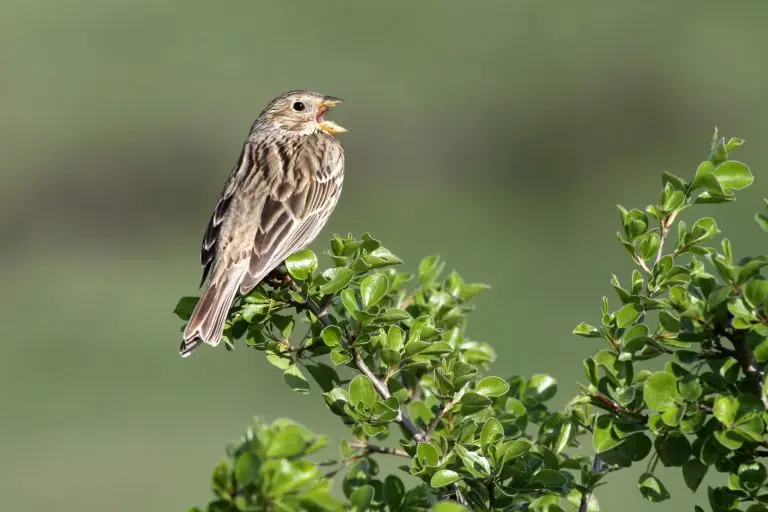
Song sparrows are not as remarkable as other backyard birds but these predominantly brown-streaked birds use their almost constant song to attract mates in spring and summer.
- Length: 4.7-6.7 in (12-17 cm)
- Weight: 0.4-1.9 oz (12-53 g)
- Wingspan: 7.1-9.4 in (18-24 cm)
Song Sparrow live all year in the Northern US. Some breed in Canada and then migrate to the Southern States.
They can be found in open, shrubby, and wet areas often perched on a low shrub singing. They are often found at backyard feeders.
Song Sparrows eat a wide variety of insects and plants including beetles, caterpillars, midges, spiders, and earthworms. They will also eat buckwheat, sunflower, raspberries, wild cherries, blackberries, wheat, and rice.
You can attract more song sparrows to your backyard feeders by putting black oil sunflower seeds, cracked corn, and nyjer on platform feeders.
10. Black-capped Chickadee
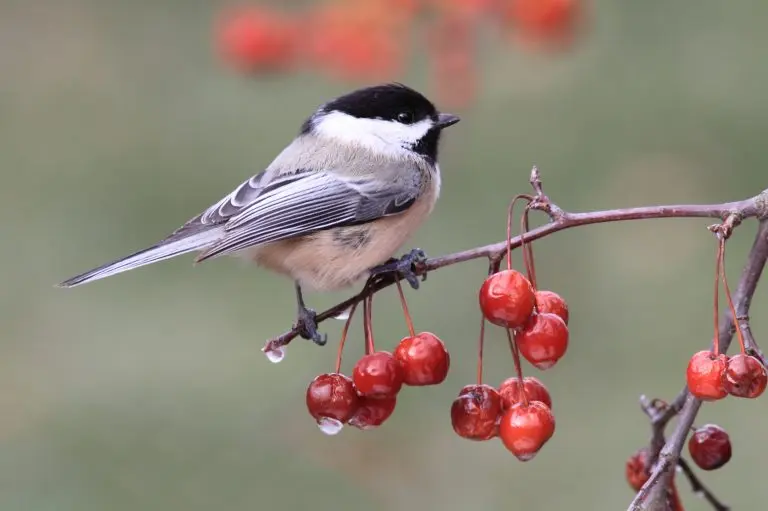
The Black-capped Chickadee is a cute bird with a big round head and tiny body. These birds will happily feed at backyard feeders and will investigate everything including you!
They have black caps and beaks, white cheeks, and are gray on the back, wings, and tail.
- Length: 4.7-5.9 in (12-15 cm)
- Weight: 0.3-0.5 oz (9-14 g)
- Wingspan: 6.3-8.3 in (16-21 cm)
Black-capped Chickadees live in the Northwest, Midwest and Northern States and Canada all year.
They can be found in forests, open woods, parks. Black-capped Chickadees eat seeds, berries and insects, spiders, and suet.
To attract more Black-capped Chickadees to your backyard try suet, sunflower seeds, and peanuts or peanut butter. They will even feed from your hand and are often one of the first birds to discover new feeders. They will also use nest boxes, especially if you fill them with wood shavings.
11. White-breasted Nuthatch
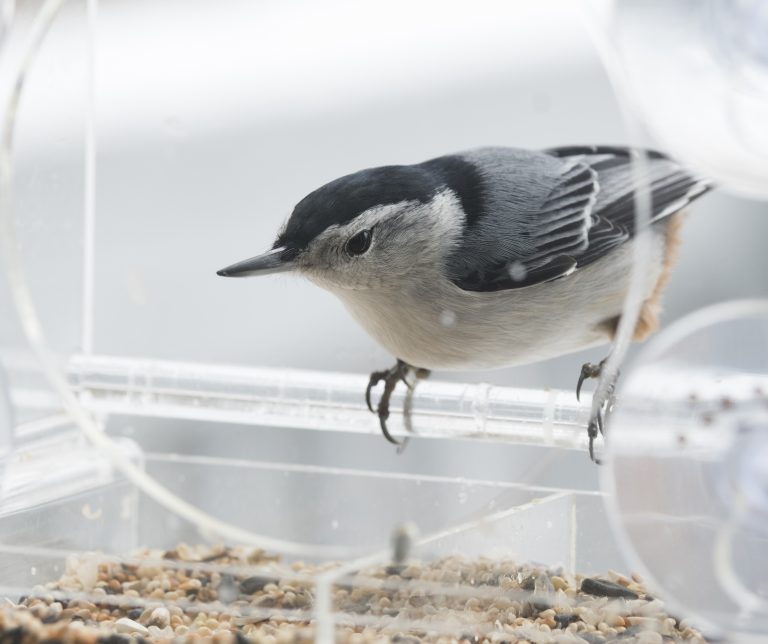
White-breasted Nuthatches are active little birds that are gray-blue on the back and white on the face and belly, with a black cap.
They will often have a chestnut color on the lower belly and under the tail.
- Length: 5.1-5.5 in (13-14 cm)
- Weight: 0.6-1.1 oz (18-30 g)
- Wingspan: 7.9-10.6 in (20-27 cm)
White-breasted Nuthatches live all year in most US States and Southern Canada.
They can be found in deciduous forests, woodland edges, parks, and yards with trees or at feeders. They mainly eat insects including beetles and their larvae, caterpillars, ants, and also spiders.
White-breasted Nuthatches also eat seeds and nuts including acorns, hawthorns, sunflower seeds, and sometimes corn crops.
They jam large nuts and acorns into tree bark and then whack them with their bills to open or ‘hatch’ them to get the seed out.
You can attract more White-breasted Nuthatches to your backyard with sunflower seeds and peanuts on tube feeders or suet feeders.
12. Chipping Sparrow
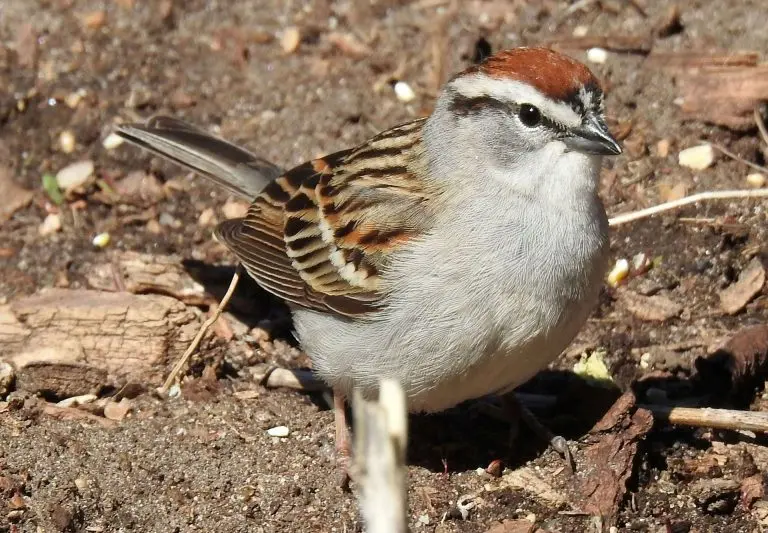
Chipping Sparrows are slender, long-tailed birds that have a grayish belly and brown and black-streaked back, with a rusty crown and black eye line. in winter the colors are more subdued.
- Length: 4.7-5.9 in (12-15 cm)
- Weight: 0.4-0.6 oz (11-16 g)
- Wingspan: 8.3 in (21 cm)
Chipping Sparrows spend their summer breeding over much of North America and Canada before flying to Mexico and Florida for winter. Some remain all year in the southern states.
They can be found in small flocks on open ground and will come to backyards for many kinds of birdseed.
13. Tufted Titmouse
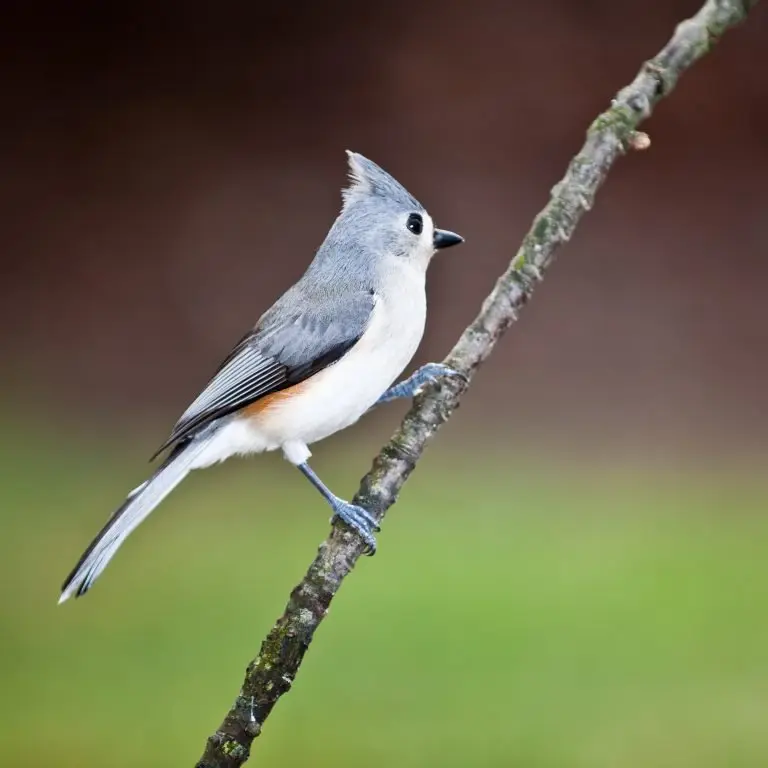
The Tufted Titmouse is gray on the back and white underneath with a cute gray crest and large eyes that often flock with chickadees, nuthatches, and woodpeckers.
- Length: 5.5-6.3 in (14-16 cm)
- Weight: 0.6-0.9 oz (18-26 g)
- Wingspan: 7.9-10.2 in (20-26 cm)
Tufted Titmice live in Eastern and Southeastern States all year
Tufted Titmice can be assertive over smaller birds and are found in woodlands, parks, and at backyard feeders. They eat mostly insects in summer including caterpillars, beetles, ants, and wasps as well as spiders and snails. They will also eat seeds, nuts, and berries and will hoard shelled seeds.
You can attract Tufted Titmice to your backyard feeders with sunflower seeds, suet, and peanuts on tube feeders or suet cages. They will also eat from platform feeders. You can also try putting up a nest box to attract a breeding pair.
14. Yellow-rumped Warbler
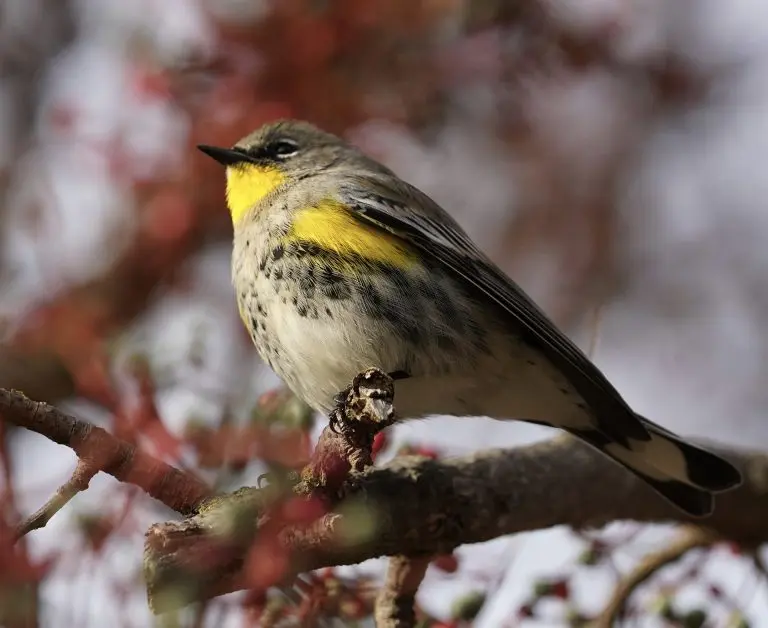
Yellow-rumped Warblers are gray with flashes of yellow on the face, sides, and rump and white in the wings.
Females may be slightly brown and winter birds are paler brown with bright yellow rumps and sides turning bright yellow and gray again in spring.
- Length: 4.7-5.5 in (12-14 cm)
- Weight: 0.4-0.5 oz (12-13 g)
- Wingspan: 7.5-9.1 in (19-23 cm)
Yellow-rumped Warblers breed predominantly in Canada, but also parts of the Rockies and the Appalachian mountains.
During migration, they can be seen in the Midwest before overwintering in the South, Southwest, and Pacific Coast as well as into Mexico and Central America.
Yellow-rumped Warblers can be found in coniferous forests, especially during the breeding season, during winter they can be found in open areas with fruiting shrubs. In summer they eat mostly insects and on migration and in winter they mostly fruit including bayberry and wax myrtle.
You can attract Yellow-rumped Warblers to your backyard with sunflower seeds, suet, raisins, and peanut butter.
15. House Sparrow
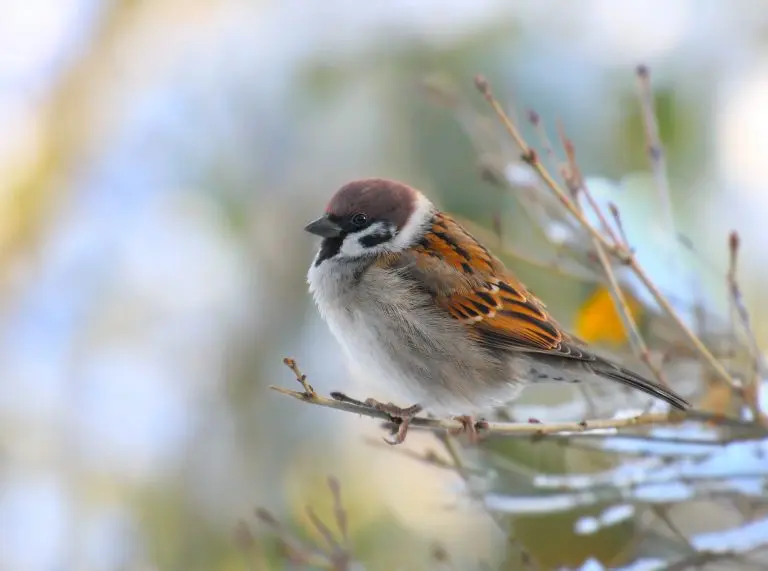
The House Sparrow is another introduced species that has done very well and is now one of the most common birds. They have gray and brown heads and white cheeks. Their backs are black and brown and their bellies are gray.
- Length: 5.9-6.7 in (15-17 cm)
- Weight: 0.9-1.1 oz (27-30 g)
- Wingspan: 7.5-9.8 in (19-25 cm)
House Sparrows live in all US States and down into Central America.
They are found near houses and buildings and can be quite tame so will eat out of your hand.
They eat mostly grain and seed as well as discarded food. They can be considered a pest as they are non-native but will be found in backyards even if you do not feed them.
You can attract more House Sparrows to your backyard feeders with most kinds of birdseed, including millet, corn, and sunflower seeds.
16. Golden-crowned Sparrow
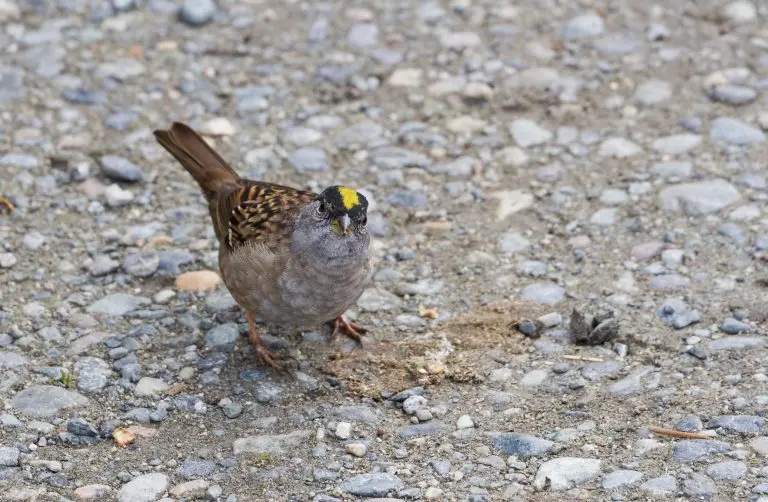
Golden-crowned Sparrows are grayish-brown underneath and streaked brown on the back. Their heads have a black crown and a bright-yellow forehead.
In winter the colors are duller with brown on the crown and the yellow forehead is also duller.
- Length: 5.9-7.1 in (15-18 cm)
- Weight: 1.1-1.2 oz (30-33 g)
Golden-crowned Sparrows breed in Alaska and Western Canada before migrating to the West Coast for winter.
In winter they can be found in weedy fields scratching for seeds such as dock, sumac, and geranium.
They also eat fruit such as apples, grapes, elderberry, and olives. Insects also make up some of their diets, such as ants, beetles, butterflies, and termites.
You can attract more Golden-crowned Sparrows to your backyard with seeds in ground feeders or plant native plants that fruit.
17. Carolina Wren
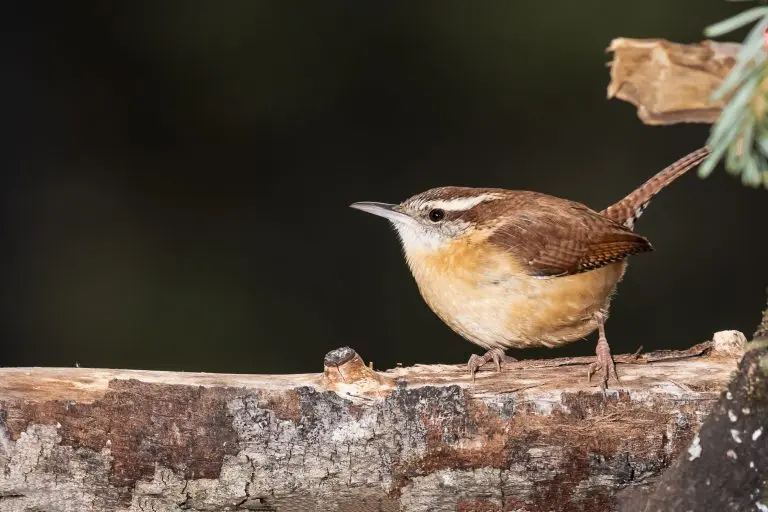
Carolina Wrens are shy birds that are dark brown on top and light brown underneath. They have a white eyebrow stripe and upright tail and loud teakettle song.
- Length: 4.7-5.5 in (12-14 cm)
- Weight: 0.6-0.8 oz (18-22 g)
- Wingspan: 11.4 in (29 cm)
Carolina Wrens are residents all year across Eastern and Southeastern States.
They can be found in woods or thickly vegetated areas and will visit backyard feeders.
You can attract more Carolina Wrens to your backyard feeders with suet feeders, hulled sunflower seeds or peanut hearts in large tube feeders or on platform feeders.
18. White-throated Sparrow
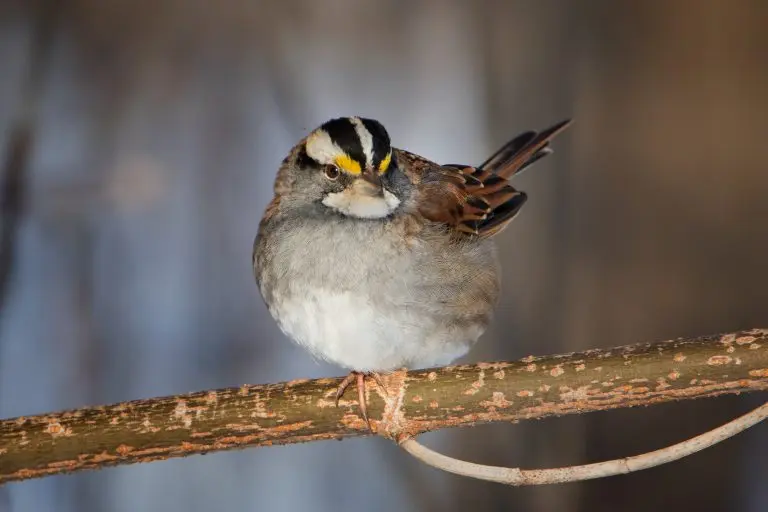
White-throated Sparrows have a distinctive black and white striped head, bright white throat, and yellow between the eye and bill. Their backs are brown and underneath is gray.
- Length: 6.3-7.1 in (16-18 cm)
- Weight: 0.8-1.1 oz (22-32 g)
- Wingspan: 7.9-9.1 in (20-23 cm)
White-throated Sparrows are migratory birds, breeding mostly in Canada before heading south in winter to Eastern and Southern States and the Pacific Coast.
You can find White-throated Sparrows on the ground in forests and woods and along the edges of wooded areas, often in large flocks.
White-throated Sparrows diet is mainly seeds of grasses and weeds as well as fruits such as grape, sumac, mountain ash, blueberry, blackberry, and dogwood. They will also eat a large number of insects from the forest floor, especially in summer.
You can attract White-throated Sparrows to your backyard feeders with millet and black oil sunflower seeds on platform feeders.
19. Ruby-crowned Kinglet
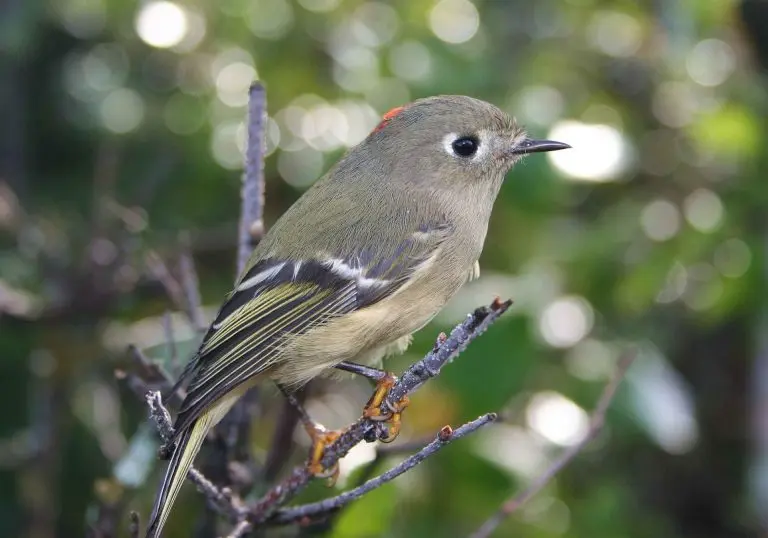
Ruby-crowned Kinglets are small songbirds that are olive-green and the males have a brilliant red crown that is usually flat so hard to see, but really great if you do.
- Length: 3.5-4.3 in (9-11 cm)
- Weight: 0.2-0.3 oz (5-10 g)
- Wingspan: 6.3-7.1 in (16-18 cm)
Ruby-crowned Kinglets breed across Canada and the western mountains before migrating to Southern and Southwestern States and Mexico for the winter.
They can also be seen during migration when they are widespread.
Ruby-crowned Kinglets can be hard to spot and they are fast-moving quiet birds that flit around in the foliage of lower branches and of shrubs and trees looking for spiders and insects.
They come to suet feeders or platform feeders for hulled sunflower seeds, peanut hearts, and mealworms.
This site is reader-supported and as an Amazon Associate, I earn a commission if you purchase a product I recommend at no extra cost to you.
The best bird feeder to attract small birds without bully birds such as grackles eating all the seed is this Woodlink caged feeder as the cage is far enough away from the feeder to prevent bigger birds just putting their heads through.
Check out these articles if you want to know more about birds in North America:
- Backyard Birds in Every State – Free Picture ID Printable
- Hummingbirds in North America
- Birds with Red Heads
20. Carolina Chickadee
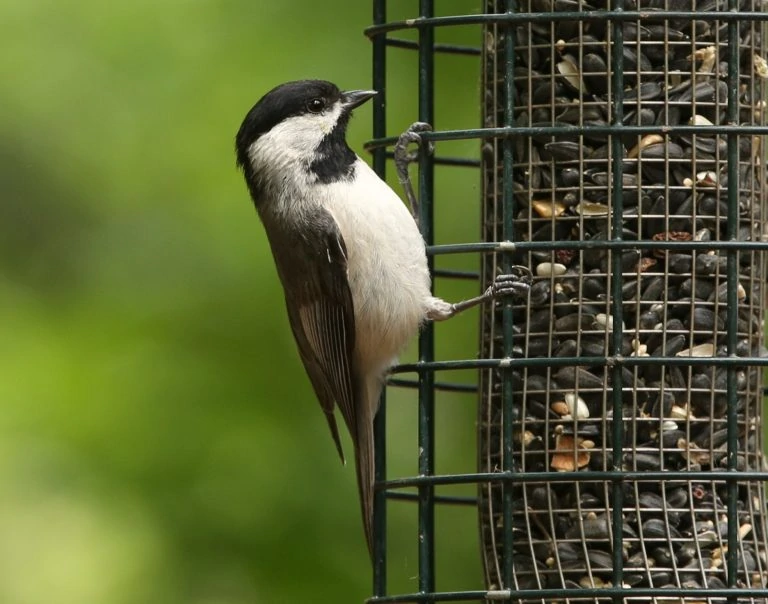
Carolina Chickadees are tiny birds with large heads, black cap and neck, white cheeks and belly, and soft gray back, wings, and tail.
- Length: 3.9-4.7 in (10-12 cm)
- Weight: 0.3-0.4 oz (8-12 g)
- Wingspan: 5.9-7.9 in (15-20 cm)
They are visually very similar to the Black-capped Chickadee and they interbreed where their range overlaps.
They can be found in forested areas, parks, and backyards in Eastern and Southeastern States all year.
You can attract more Carolina Chickadees to your backyard feeders with Black oil sunflower seeds, Nyjer seeds, suet feeders, or peanuts. They will feed on most types of feeders including tube feeders, suet cages, or platform feeders. They will also nest in nest boxes or nest tubes.
21. Tree Swallow
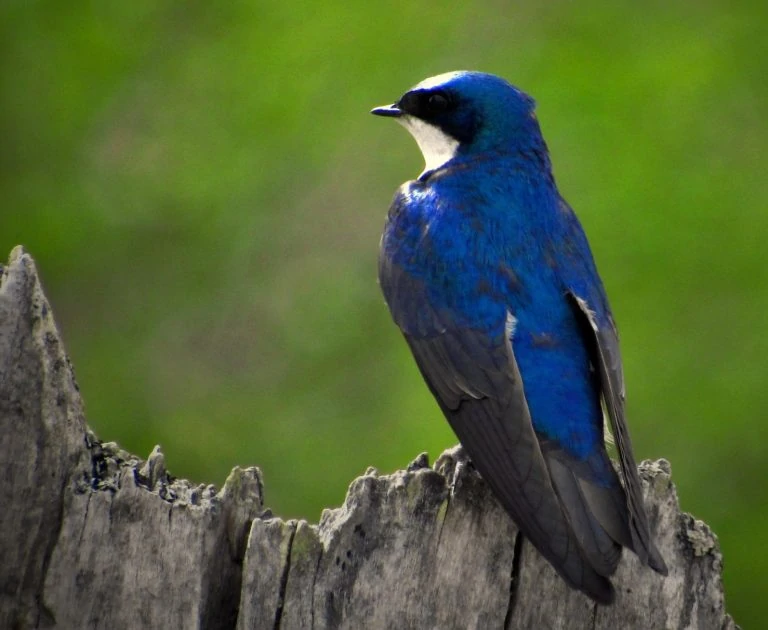
Tree Swallows are small birds that are blue-green on the back and white below, with darker gray wings in the males. Females are browner in color.
- Length: 4.7-5.9 in (12-15 cm)
- Weight: 0.6-0.9 oz (16-25 g)
- Wingspan: 11.8-13.8 in (30-35 cm)
Tree Swallows spend their summer breeding over much of the US, Canada, and Alaska before migrating to the Gulf Coast, Florida, and Mexico and along the southern border.
They can be seen during migration over southern states and can form huge flocks in the hundreds of thousands.
Tree Swallows can be found in wooded swamps, fields, marshes, and near water that provide the flying insects that they feed on.
To attract more Tree Swallows to your backyard try nest boxes as they readily take to them.
22. Yellow Warbler
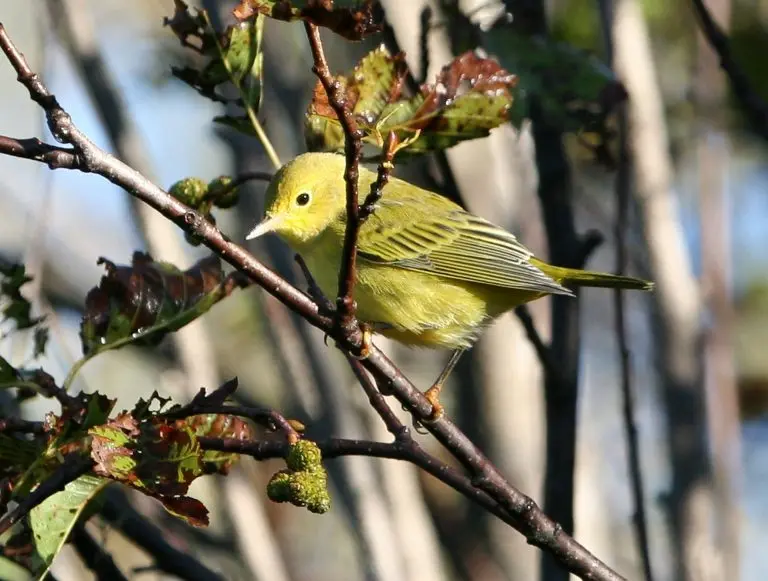
Yellow Warblers are small bright yellow birds with a yellow-green back, and the males have chestnut streaks on the breast, which are a common sight in summer.
- Length: 4.7-5.1 in (12-13 cm)
- Weight: 0.3-0.4 oz (9-11 g)
- Wingspan: 6.3-7.9 in (16-20 cm)
Yellow Warblers migrate a long distance to breed over much of North America before heading into Central and Northern South America for winter.
They can be seen during migration in The South.
Yellow Warblers can be found along streams and wetlands in thickets and along the edges of fields foraging for insects, including caterpillars, midges, beetles, bugs, and wasps.
Warblers are hard to attract to your backyard as they are shy and eat mainly insects. To attract Yellow Warblers you can try suet, oranges, and peanut butter and plant berries and native plants that attract insects, so no pesticides or being too tidy! Birdbaths with fountains with secluded thickets nearby to provide protection.
23. House Wren
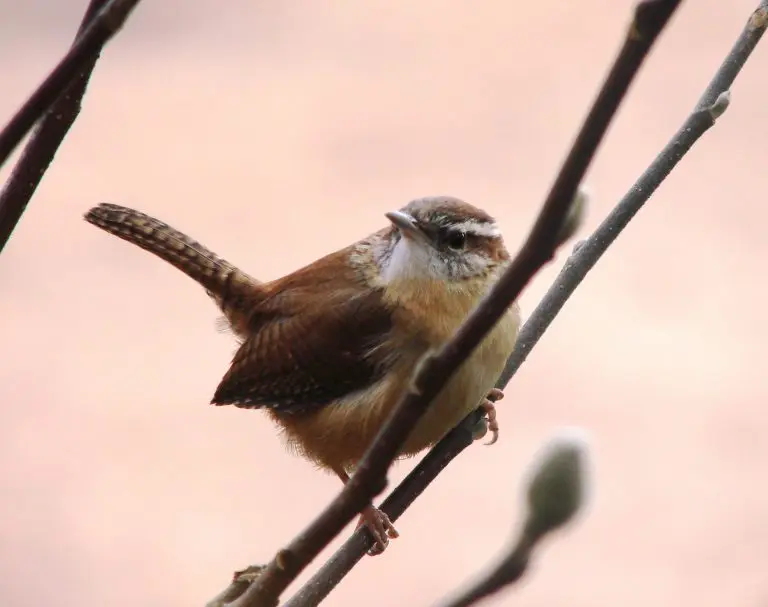
House Wrens are small nondescript brown birds with darker barred wings and tails and a paler throat.
- Length: 4.3-5.1 in (11-13 cm)
- Weight: 0.3-0.4 oz (10-12 g)
- Wingspan: 5.9 in (15 cm)
House Wrens spend their summer breeding in most states before migrating to The South and Mexico for winter.
House Wrens can be found in backyards, parks and open woods foraging for insects and spiders.
They can often be found energetically hopping through tangles and low branches with their tails up, stopping to sing their cheerful song.
House Wrens are fierce for their size, when it comes to getting the best nest holes, they will often harass larger birds, sometimes dragging eggs or nestlings out of a nest site they want.
You can attract more House Wrens to your backyard by leaving piles of brush or putting up a nest box.
24. Red-eyed Vireo
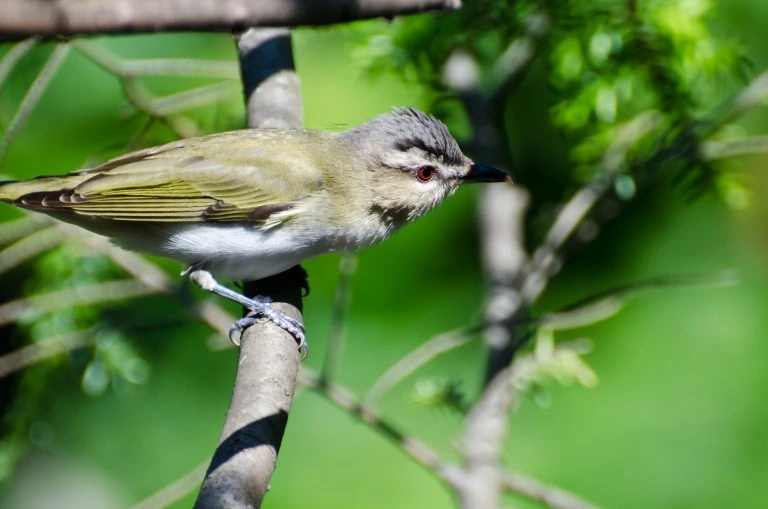
Red-eyed Vireos are olive-green on their backs and white below. They have gray crowns and a white stripe above the eye. Their red eyes may appear dark from a distance or in some light conditions.
- Length: 4.7-5.1 in (12-13 cm)
- Weight: 0.4-0.9 oz (12-26 g)
- Wingspan: 9.1-9.8 in (23-25 cm)
Red-eyed Vireos spend their summer breeding over much of Canada and the United States, except Alaska, the far north of Canada, and the Southwestern States. They spend winter in South America.
They are common in forests during the summer but often remain high up in the canopy.
25. Cedar Waxwing
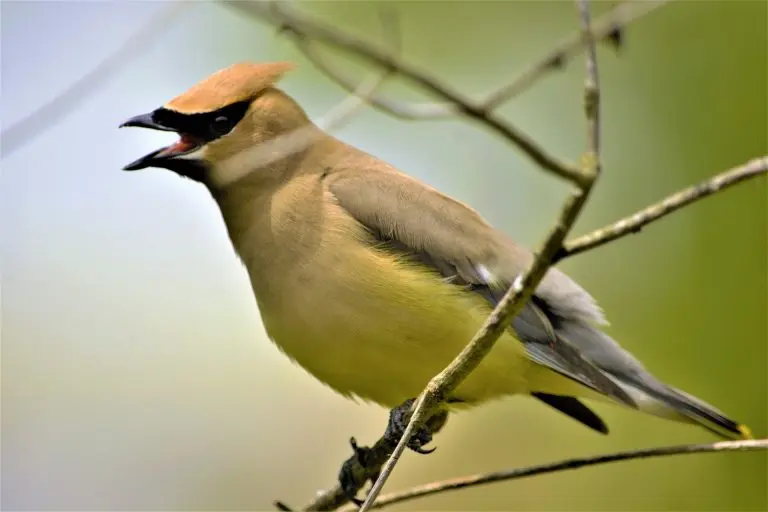
Cedar Waxwings are elegant social birds that are pale brown on the head, chest, and crest, which fades to gray on the back and wings and tail.
Their belly is pale yellow and there is bright yellow on the tip. They have a narrow black mask over their eyes and bright red on the wingtips.
- Length: 5.5-6.7 in (14-17 cm)
- Weight: 1.1 oz (32 g)
- Wingspan: 8.7-11.8 in (22-30 cm)
Cedar Waxwings breed in Canada before heading to the Southern US for winter. They are resident all year in the Northern US States.
They make a high-pitched call and can be found in berry bushes, in woodlands, and along streams.
To attract Cedar Waxwings to your backyard plant native trees and shrubs that have small fruit such as serviceberry, dogwood, juniper, winterberry, and hawthorn. You can also try fruit on platform feeders.
26. Indigo Bunting
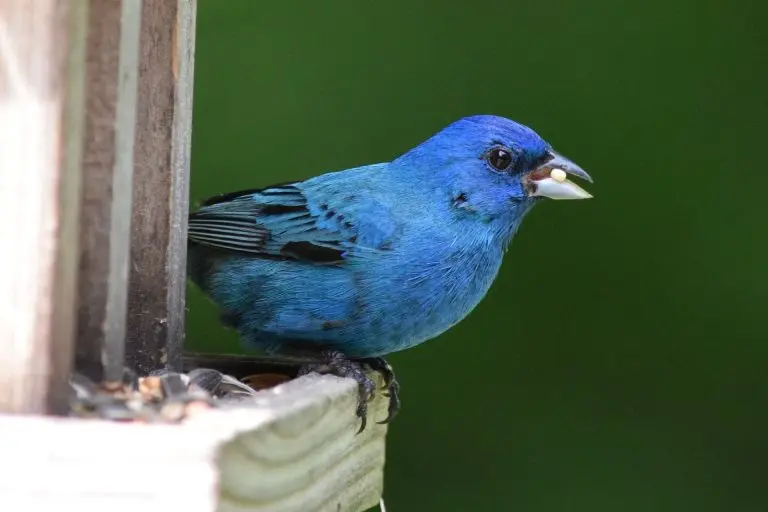
Indigo Buntings are small birds with the males being bright blue with streaks of black in the wings and tail, females are brown.
- Length: 4.7-5.1 in (12-13 cm)
- Weight: 0.4-0.6 oz (12-18 g)
- Wingspan: 7.5-8.7 in (19-22 cm)
Indigo Buntings migrate far from breeding grounds in the Eastern States to winter grounds in Florida, Central and South America, and the Caribbean.
Indigo Buntings can be found in weedy fields and shrubby areas foraging for seeds and insects. You can attract more to your backyard with small seeds such as nyjer and thistle.
27. Great Crested Flycatcher
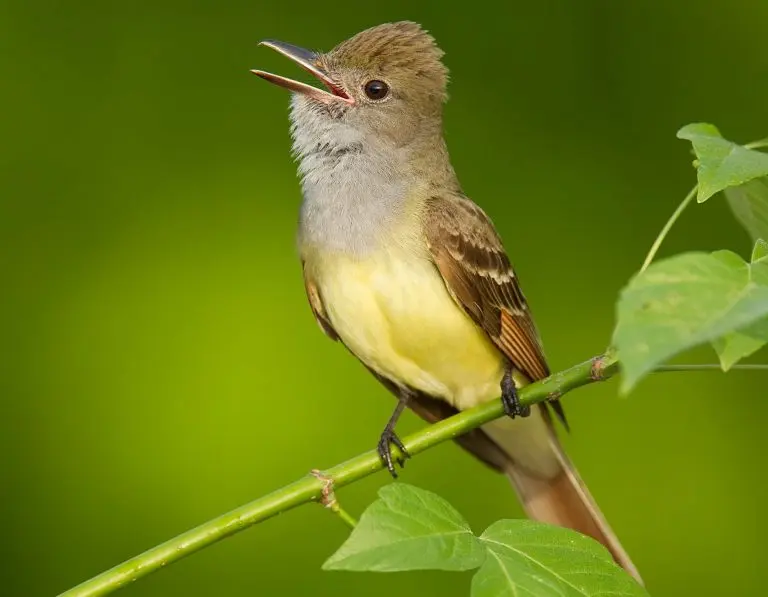
Great Crested Flycatchers are brown on the back with a yellow belly and gray throat. They have reddish flashed in the wing and tail feathers. The crest is not very obvious.
- Length: 6.7-8.3 in (17-21 cm)
- Weight: 0.9-1.4 oz (27-40 g)
- Wingspan: 13.4 in (34 cm)
Great Crested Flycatchers breed over much of Eastern North America and spend the winter in Southern Florida, Southern Mexico, and Central America.
They sit perched up high in woodland waiting for large insects flying such as butterflies, grasshoppers, moths, wasps, and also spiders. They can be found in mixed woodlands and at the edges of clearings, parks, and tree-lined neighborhoods or perched on fenceposts or other man-made structures. They will also eat berries and small fruit.
To attract more Great Crested Flycatchers to your backyard try planting native species of plants and leaving brush piles to attract insects. plant berry-producing plants and put up a nest box as they readily take up residence in them.
28. Baltimore Oriole
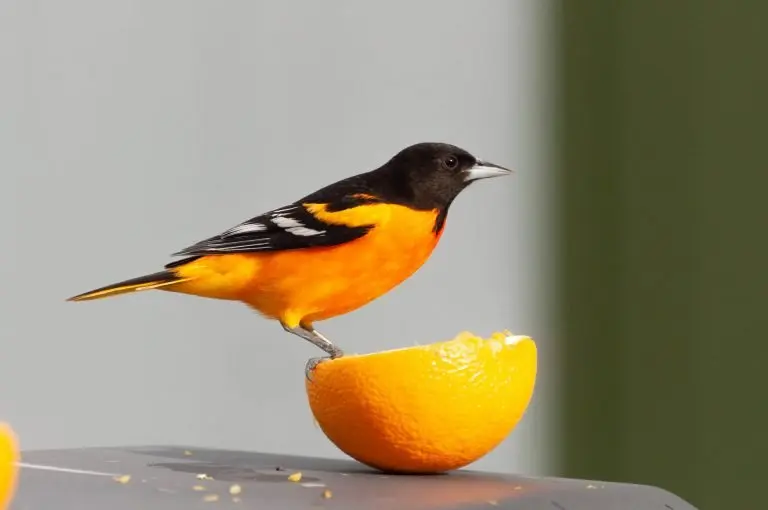
Baltimore Orioles are a colorful sign of spring in the east of North America. The adult males are bright orange and black with white wing bars on the black wings.
Females are yellowish underneath and on the head and grayish-brown on the wings, their backs or brownish-yellow. They are about the size of a Robin but more slender and are members of the blackbird family.
- Length: 6.7-7.5 in (17-19 cm)
- Weight: 1.1-1.4 oz (30-40 g)
- Wingspan: 9.1-11.8 in (23-30 cm)
Breeding in Eastern and Central States, including Central-Southern Canadian provinces and along the southern border with the US, from April.
Baltimore Orioles, then migrate to Florida, Central America, and the Caribbean for winter, leaving as early as July.
They make incredible hanging bag-like nests woven from fibers.
Baltimore Orioles can be found high up in open woodland, riverbanks, and forest edges foraging for insects and fruit and they often come to parks and backyards.
Their diet is insects such as beetles, crickets, and grasshoppers as well as spiders and snails and they help eat pest species. They eat a wide variety of fruits and can damage crops such as raspberries, mulberries, cherries, bananas, and oranges.
To attract more Baltimore Orioles to your yard try oranges cut in half on a platform feeder or hanging from trees. Also, oriole feeders filled with sugar water. Plant fruit and nectar plants such as raspberries, crab apples, and trumpet vines.
29. Eastern Bluebird
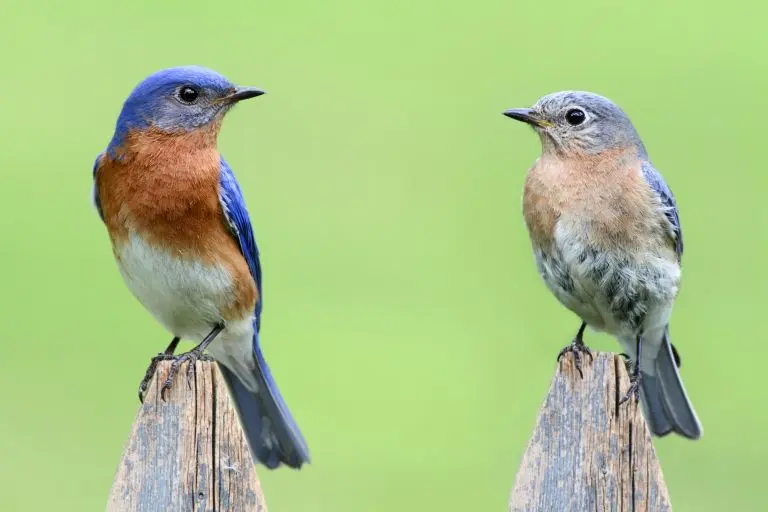
Eastern Bluebirds are small thrushes with big, rounded heads, large eyes, and big bellies.
The males are deep blue on the back and a reddish color underneath. Females are grayer above with some blue in the wings and tail and a less vivid orange-brown breast.
- Length: 6.3-8.3 in (16-21 cm)
- Weight: 1.0-1.1 oz (28-32 g)
- Wingspan: 9.8-12.6 in (25-32 cm)
They live all year over most of their range in the Eastern States but may migrate south for winter from the north.
They live in meadows and can be spotted perched on wires and posts or low branches looking for insects.
You can attract more Eastern Bluebirds to your backyard by offering mealworms and nest boxes if your yard is fairly open and spacious.
This site is reader-supported and as an Amazon Associate, I earn a commission if you purchase a product I recommend at no extra cost to you.
The best bird feeder to attract small birds without bully birds such as grackles eating all the seed is this Woodlink caged feeder as the cage is far enough away from the feeder to prevent bigger birds just putting their heads through.
Check out these articles if you want to know more about birds in North America:
- Backyard Birds in Every State – Free Picture ID Printable
- Hummingbirds in North America
- Birds with Red Heads
30. Eastern Towhee
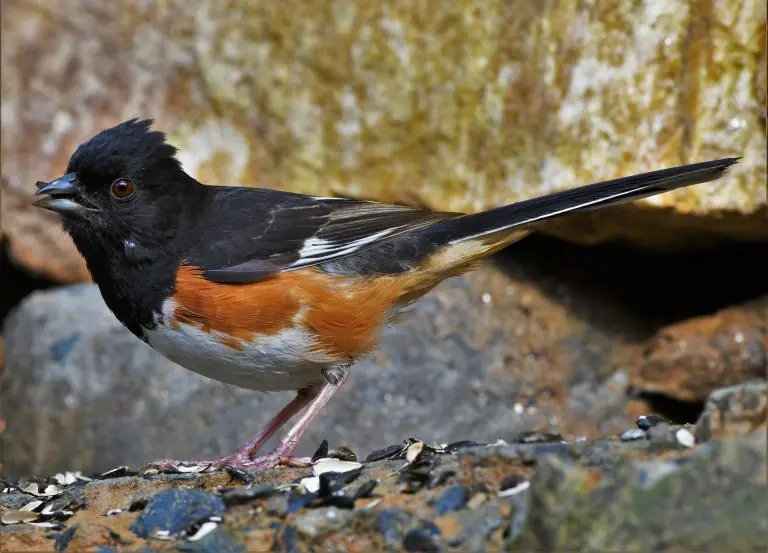
Eastern Towhees are striking large sparrows, about the size of Robin, with a black head, throat, and back, reddish sides, log tails, and a white belly in the males. The females are similar but with brown instead of black.
- Length: 6.8-8.2 in (17.3-20.8 cm)
- Weight: 1.1-1.8 oz (32-52 g)
- Wingspan: 7.9-11.0 in (20-28 cm)
Eastern Towhees live all year in Southeastern States but birds further north move south for the winter and they may only appear in winter on the western edge of their range.
Eastern Towhees spend their time rummaging in the undergrowth and can be found along the edges of forests and thickets.
Eastern Towhees visit feeders for fallen seed if your yard has overgrown borders and will also visit platform feeders for black oil sunflower seeds, hulled sunflower seeds, cracked corn and millet.
31. Annas Hummingbird
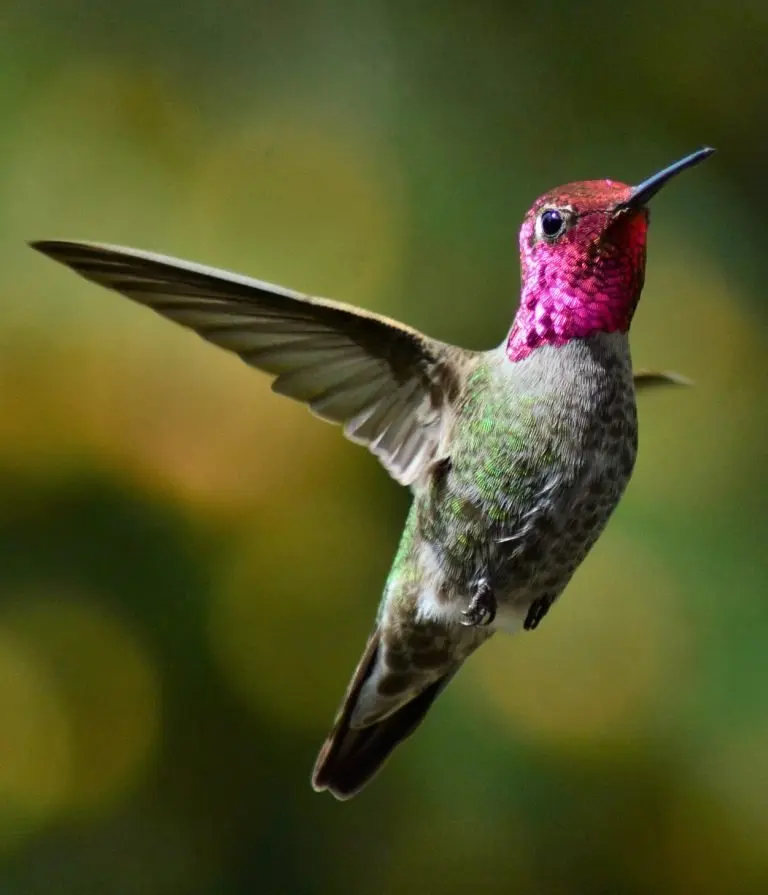
Anna’s Hummingbirds are tiny birds that are mostly green and gray. The male’s head and throat are iridescent reddish-pink the female’s throat is grayish with bits of red spotting.
- Length: 3.9 in (10 cm)
- Weight: 0.1-0.2 oz (3-6 g)
- Wingspan: 4.7 in (12 cm)
Unusually Anna’s Hummingbirds do not migrate and are the most common hummingbird along the Pacific Coast.
They make a dramatic dive display during courtship as the males climb up to 130 feet into the air before diving back to the ground with a burst of noise from their tail feathers.
They can be found near large colorful blossoms during the spring and readily visit hummingbirds feeders that you can fill with homemade hummingbird food and they may visit feeders all year.
32. Northern Parula
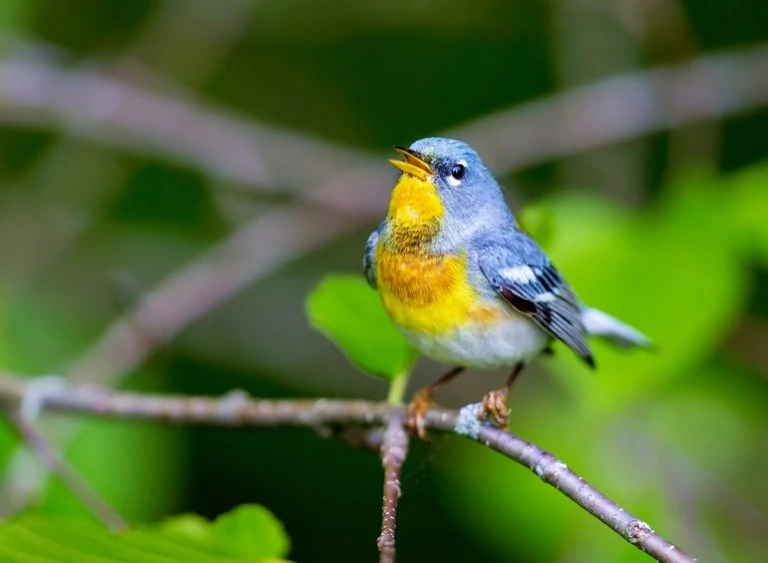
With a colorful contrast of gray and yellow the Northern Parula is a cheery warbler found in woodlands.
They are bluish-gray on the back with a yellow patch on the back and with two white wingbars. Males have a chestnut band that separates the yellow throat and chest that adorns both males and females. Females are paler than males.
- Length: 4.3-4.7 in (11-12 cm)
- Weight: 0.2-0.4 oz (5-11 g)
- Wingspan: 6.3-7.1 in (16-18 cm)
Northern Parulas breed in the Eastern States and Southeastern Canada before heading to Central America and the Caribbean for winter. They may remain for winter in Southern Florida.
Feeding on insects high up in deciduous forests and building nests in long clumps of lichen and moss that drape from the branches. The best way to spot them is by looking up at large clumps of hanging moss in the summer.
33. Blue-gray Gnatcatcher
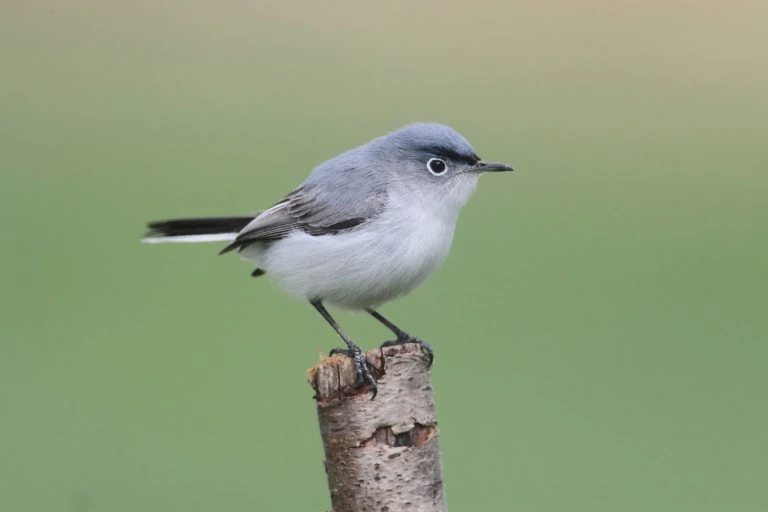
A tiny songbird in a soft blue-gray color on the back and grayish-white underneath. They have a black tail and patches on their wings. Males have a distinctive black ‘V’ shape on their foreheads in summer.
They have long tails and legs and small, thin, straight bills.
- Length: 3.9-4.3 in (10-11 cm)
- Weight: 0.2-0.3 oz (4.8-8.9 g)
- Wingspan: 6.3 in (16 cm)
Blue-gray Gnatcatchers breed in deciduous forests in the Southern and Eastern States before heading south. They do also remain all year in Florida and in southern coastal areas.
Nests of Blue-gray Gnatcatchers look similar to hummingbird nests as they are small and built onto branches so they look like a tree knot covered in lichen.
Feeding on insects and spiders by constantly hopping around and scaring them by flicking their tail up and down.
34. Eastern Phoebe

Eastern Phoebes are plump songbirds that are grayish-brown on the back and whitish underneath and with a darker head.
- Length: 5.5-6.7 in (14-17 cm)
- Weight: 0.6-0.7 oz (16-21 g)
- Wingspan: 10.2-11.0 in (26-28 cm)
Eastern Phoebes are migratory birds, breeding across Northeastern and Central States and into Canada before migrating to the Southeast and Mexico for winter.
Some birds may remain all year towards the south of their range.
Eastern Phoebes tend to be found alone, rather than in pairs or flocks, in quiet woodland wagging their tails from low perches.
As they are flycatchers, flying insects make up the most of their diet but they will also eat spiders and other insects, small fruit and seeds. They often nest on bridges and barns or houses, making a nest out of mud and grass.
To attract more Eastern Phoebes to your backyard try putting up a nest box or native plants that produce berries.
35. Hairy Woodpecker
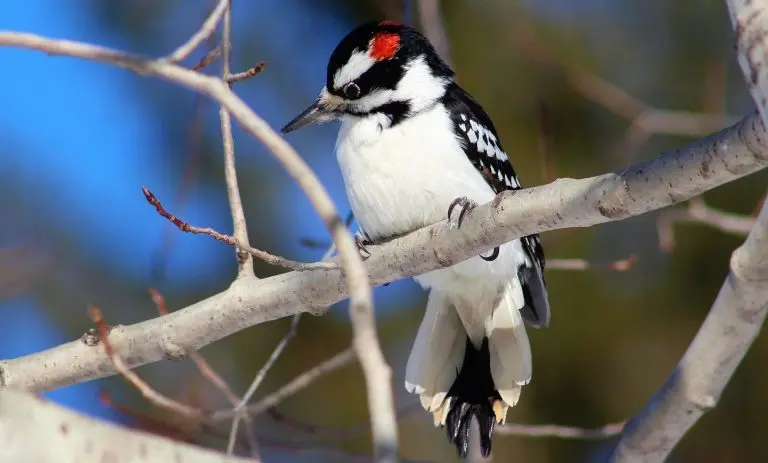
These medium-sized woodpeckers have a black and white pattern and a large white patch on their backs. The males have a flash of red towards the back of their heads.
Length: 7.1-10.2 in (18-26 cm)
Weight: 1.4-3.4 oz (40-95 g)
Wingspan: 13.0-16.1 in (33-41 cm)
Hairy Woodpeckers range over most of North America.
It is visually similar to the Downy woodpecker but larger. As it is often found in the same areas it is hard to tell them apart.
You can find Hairy Woodpeckers in woodlands on trunks or main branches of large trees but they are also found in a wide variety of habitats including woodlots, parks, and cemeteries. Hairy Woodpeckers’ diet is mostly insects.
Hairy Woodpeckers benefit from squirrel-proof suet feeders with a cage to stop larger birds from taking all the turns.
36. Pine Siskin
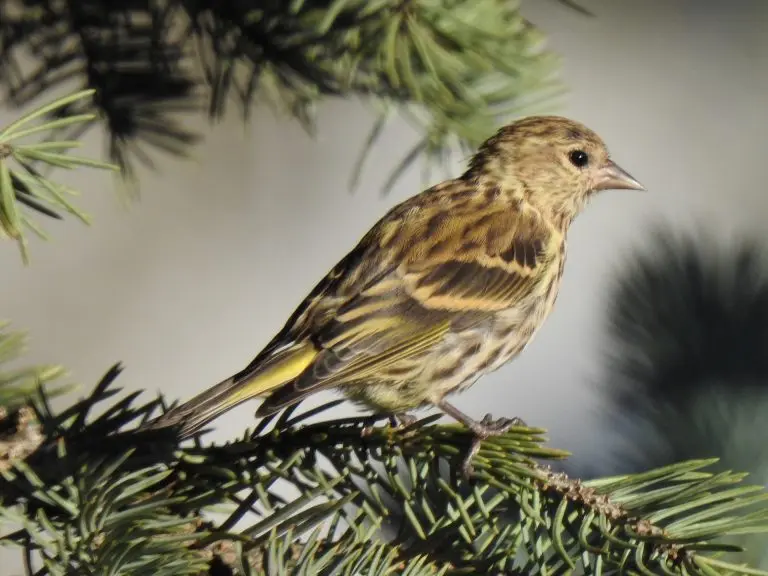
Pine Siskins are small finches that are streaked brown with yellow streaks in the wing and tail. They have a forked tail and pointed wings, with a short pointed bill.
- Length: 4.3-5.5 in (11-14 cm)
- Weight: 0.4-0.6 oz (12-18 g)
- Wingspan: 7.1-8.7 in (18-22 cm)
Pine Siskins remain all year in the pine forests in the Western States and along the Canadian Border. Some also breed in Canada before heading south for winter.
They can be found over much of North America depending on pine cone crops.
As their name suggests Pine Siskins predominantly eat seeds from conifers but they also eat young buds and seeds from grasses and weeds.
Pine Siskins can be attracted to backyards with thistle and nyjer feeders but also black oil sunflower seeds and suet.
37. Ruby-throated Hummingbird
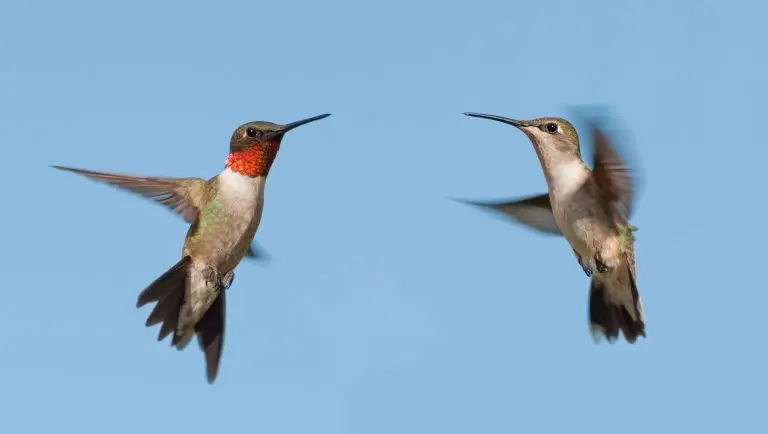
The Ruby-throated Hummingbirds are bright green on the back and crown, with a gray-white underside and the males have an iridescent red throat.
Female Ruby-throated Hummingbirds are green on the back and white underneath with brownish crowns and sides.
- Length: 2.8-3.5 in (7-9 cm)
- Weight: 0.1-0.2 oz (2-6 g)
- Wingspan: 3.1-4.3 in (8-11 cm)
The Ruby-throated Hummingbird is the only breeding hummingbird in Eastern North America, they then migrate further south to Central America for winter.
Some migrate over the Gulf of Mexico or some migrate through Texas around the coast.
These tiny birds zip from one nectar source to the next or catch insects in midair or from spider webs. They occasionally stop on a small twig but their legs are so short they cannot walk, only shuffle along a perch.
Flowering gardens or woodland edges in summer are the best places to find them when out. They are also common in towns, especially at nectar feeders.
38. Lesser Goldfinch
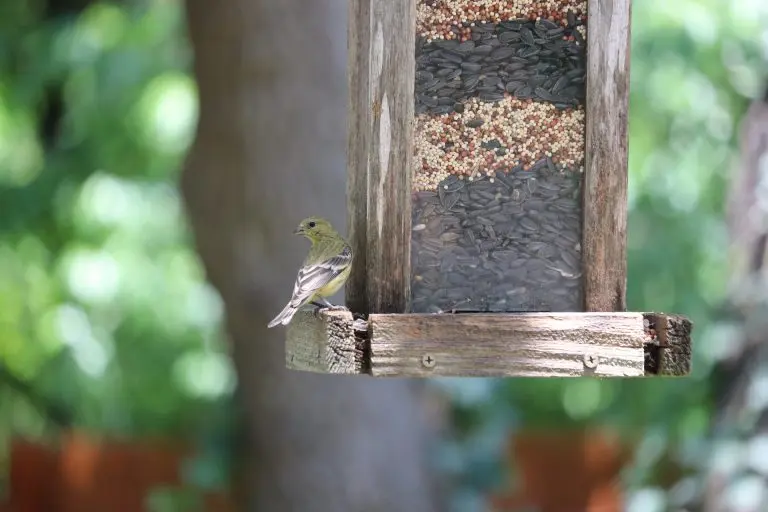
Lesser Goldfinches are tiny bright yellow and black songbirds with long pointed wings and short notched tails. Females have olive backs and are more dull yellow underneath.
- Length: 3.5-4.3 in (9-11 cm)
- Weight: 0.3-0.4 oz (8-11.5 g)
- Wingspan: 5.9-7.9 in (15-20 cm)
Lesser Goldfinches live in the Southwest and Westcoast all year, but some may move down from higher elevations in winter.
Lesser Goldfinches can be found in large flocks in open habitats including thickets, weedy fields, forest clearings parks, and gardens. They forage for seeds, especially sunflower seeds, but also fruits from elderberry, coffeeberry, and buds from cottonwoods, willows, sycamores, and alders.
You can attract more Lesser Goldfinches to your yard with sunflower seeds and nyjer in tube feeders or platform feeders.
39. Chestnut-backed Chickadee
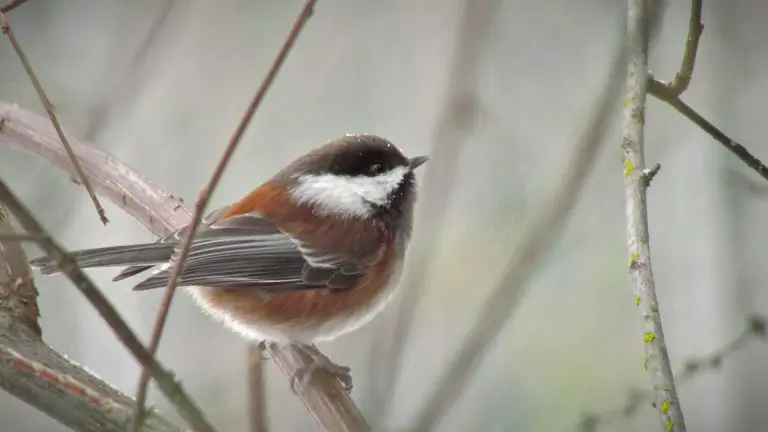
Chestnut-backed Chickadees are tiny birds with black and white on their heads, rich chestnut on the back, and with gray wings and bellies.
- Length: 3.9-4.7 in (10-12 cm)
- Weight: 0.3-0.4 oz (7-12 g)
- Wingspan: 7.5 in (19 cm)
They live flocks in wet evergreen forests along the Pacific Northwest Coast and are regular visitors to backyard feeders.
Insects including caterpillars, spiders, wasps, and aphids make up most of their diet, with seeds, berries, and fruit making up the rest.
You can attract Chestnut-backed Chickadees to your yard with black-oil sunflower seeds, suet, nyjer, peanuts, or mealworms in tube feeders, platform feeders, or suet cages. They will also use nest boxes.
40. Bushtit
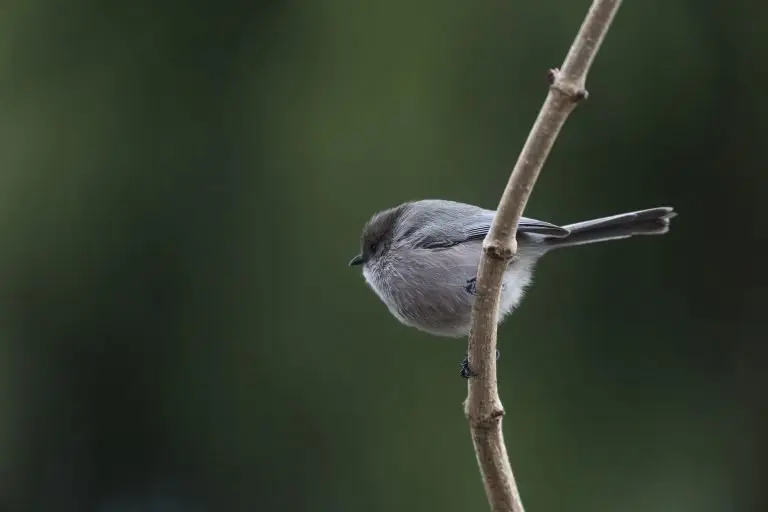
Bushtits are tiny, almost round, soft gray birds with a long tail and stubby bill. They have slight brown tinges to the face and underneath.
- Length: 2.8-3.1 in (7-8 cm)
- Weight: 0.1-0.2 oz (4-6 g)
Bushtits live all year in Western US States.
They can be found in open woodland or scrubby areas, parks, and backyards. Their diet is insects and spiders, such as caterpillars, beetle, wasps, and ants.
Bushtits make amazing hanging nests out of plant material and spider webs that hang down about a foot and may take a month to build.
To attract more bushtits to your yard plant native shrubs and trees and they may visit feeders filled with black oil sunflower seeds, suet, or mealworms from platform feeders.
This site is reader-supported and as an Amazon Associate, I earn a commission if you purchase a product I recommend at no extra cost to you.
The best bird feeder to attract small birds without bully birds such as grackles eating all the seed is this Woodlink caged feeder as the cage is far enough away from the feeder to prevent bigger birds just putting their heads through.
Check out these articles if you want to know more about birds in North America:
- Backyard Birds in Every State – Free Picture ID Printable
- Hummingbirds in North America
- Birds with Red Heads
How to Identify Birds
Here are some tips to help you identify birds so wherever you are birding in Florida you have the knowledge to document and find the bird in a guide:
- Size – Size is the easiest thing to notice about a bird. Birds are often measured in inches or centimeters in guide books. It’s best to take a note of the bird in terms of small, medium, or large to be able to look for it later. A small bird is about the size of a sparrow, a medium bird is about the size of a pigeon and a large bird is the size of a goose.
- Shape – Take note of the silhouette of the bird and jot it down or draw the outline. Look at tail length, bill shape, wing shape, and overall body shape.
- Color pattern – Take a note of the main color of the head, back, belly, and wings, and tail for the main color and then any secondary colors or patterns. Also take note of any patterns such as banding, spots, or highlights.
- Behavior – Are they on the ground or high up in the trees. Are they in flocks or on their own? Can you spot what they are eating?
- Habitat – Woodlands, parks, shrubs, grasslands or meadows, shore or marsh.
- Use a bird identification app such as those created by ebird or Audubon

